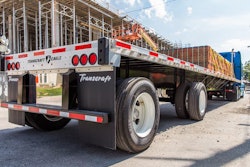 Rusty Rush, chairman, CEO and president, Rush Enterprises
Rusty Rush, chairman, CEO and president, Rush EnterprisesRush Enterprises announced it has achieved record revenues of $5.8 billion and net income of $141.6 million for the year ended December 31, 2019, compared with revenues of $5.5 billion and net income of $139.1 million during the same period a year ago.
“Though we experienced declines in new Class 8 truck sales and aftermarket products and services sales in the fourth quarter, our overall performance for the full year 2019 was strong, primarily due to a healthy economy and activity throughout the markets we support,” said W.M. “Rusty” Rush, Rush chairman, CEO and president. “In addition, the successful execution of our strategic initiatives continues to contribute to our parts and service revenue growth and we gained market share in our new medium-duty truck sales,” he added.
Gaining market share, in general, was a key theme of Rush’s at a press conference held in December during the company’s annual Tech Skills Rodeo.
“You’re coming off of the two biggest years back to back since 2005 and 2006. From a retail sales perspective, it’s going to go backward [in 2020], we all know that, it’s just how far backward is it going to be,” Rush said at the press conference.
“We’re going to have to continue to stay focused on our strategic initiatives, which will continue to raise our share of the marketplace. Whatever the size of the market, we want more share,” Rush said.
Aftermarket products and services
According to the earnings report, Rush’s aftermarket products and services accounted for approximately 64.9 percent of the company’s total gross profits in 2019, with parts, service and collision center revenues reaching $1.8 billion, up 5.5 percent compared with 2018.
“In 2019, we continued to invest in internal and customer-facing technologies, such as our e-commerce platform and RushCare Parts Connect. We also continued to grow our all-makes parts product offerings and expanded our aftermarket products and services sales force,” Rush said.
“Despite our strong aftermarket products and services sales growth for the full year 2019, activity from our energy customers declined throughout 2019, negatively impacting our aftermarket products and services results, particularly in the fourth quarter. Widespread weakness in aftermarket demand, typical seasonal decline and the timing of the mid-week holidays further impacted our fourth quarter results,” he said.
“We expect that parts and service activity throughout the industry will be relatively flat in 2020 compared to 2019. We believe aftermarket demand from our energy sector customers has bottomed, which will limit our year-over-year aftermarket growth in the first half of 2020 because stronger energy sector demand existed in the first half of 2019,” said Rush. “We remain focused on our strategic initiatives and have ambitious targets for improving efficiency and productivity in our parts fulfillment processes to facilitate additional parts sales. We are also excited about RushCare Complete, which we launched in the summer of 2019,” Rush said.
Truck Sales
Rush said the company’s new Class 8 truck sales grew steadily from the first quarter of 2019 through the third quarter of 2019, primarily because of the healthy economy and strong activity across the market segments it supports.
“In the fourth quarter of 2019, as predicted by ACT Research, all new U.S. Class 8 truck retail sales declined compared to the fourth quarter of 2018, and our results were further negatively impacted by the timing of certain fleet deliveries,” he said.

“Declining freight rates, coupled with the fact that this is an election year, generally results in our customers being more cautious with their purchase decisions. That said, freight rates are expected to improve in the second half of the year, the housing sector is growing and the economy is healthy. Our team will continue to closely monitor market conditions impacting Class 8 truck sales, and we believe that we are well positioned to gain market share in 2020,” Rush said.
The company sold 14,470 new Class 4-7 medium-duty commercial vehicles in 2019, an increase of 11.7 percent compared with 2018, accounting for 5.4 percent of the total U.S. market and significantly outpacing the industry, according to the earnings report. New U.S. Class 4-7 medium-duty commercial vehicle sales were 266,977 units in 2019, up 3.4 percent over 2018.
“By offering a breadth of options from the five medium-duty manufacturers we represent, we continue to evolve to meet our customers’ needs, moving us further towards our medium-duty commercial vehicle sales strategic goals,” Rush said.
Rush sold 7,741 used vehicles in 2019, a 3.5 percent decrease compared with 2018.
“Record new truck deliveries in the past few years caused an oversupply of used trucks in the market in 2019, which put pressure on used truck values in the second half of the year. Currently, we believe that used truck values continue to depreciate significantly faster than what is considered a normal rate,” Rush said. “But we believe our inventory, in terms of quantity and value, is well-positioned to meet current market demand.”
For more company earnings information, CLICK HERE.










